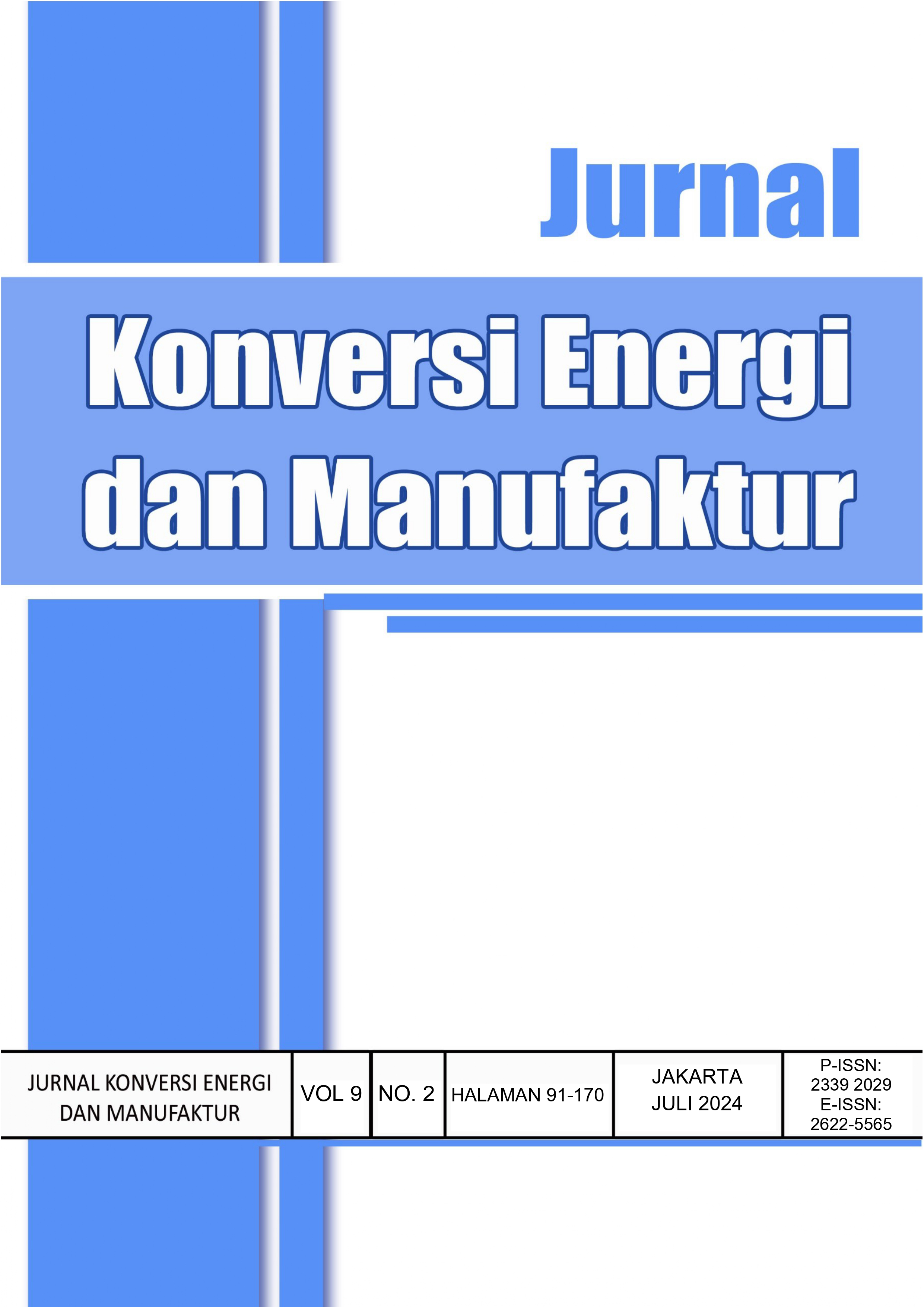ANALISIS KECEPATAN KELUARAN ANGIN KONDENSOR AC TERHADAP JENIS–JENIS BLADE GENERATOR LISTRIK DENGAN KOMPUTASI FLUIDA DINAMIK
Analysis of AC Condensor Wind Output Speed to Types of Electric Blade Generator with Computational Fluid Dynamics
DOI:
https://doi.org/10.21009/JKEM.9.2.1Keywords:
Air Flow Rate, Blade Type, Air Conditioner, Computational Fluid DynamicAbstract
Electrical energy is widely used for household and industrial purposes, so the need for electrical energy will continue to increase every year. Therefore, it is necessary to develop an electrical energy generation system that comes from renewable energy such as wind. Currently, not much is known about the use of wasted wind from air conditioner (AC) condensers. The blow of wind can be used to produce electrical energy, so it is necessary to make wind-powered electric generator blades from the condenser output. The blade that will be designed is a three-blade model, so it is hoped that it can rotate the generator optimally. The purpose of this research is to design a three-blade type that can optimize the rotation of the electric motor/generator and get the maximum number of revolutions with a three-blade design because this design provides better stability and more efficiency. One way of making the design is to make simulation variations with computational fluid dynamics (CFD) in order to find out the right blade design to rotate the generator and find out the wind blowing from the air conditioner (AC) condenser that crosses the blade. In this study, three simulations were carried out to get maximum results, namely 390 rpm at 42 °C with a velocity of 10.7 m/s and a pressure of 34.4 Pa. To be able to determine the effectiveness of the AC condenser wind output speed with a three-blade design.
References
[2] M. I. Abdullah, “Analisis Rancang Bangun Pembangkit Listrik Generasi 3 Tenaga Angin Luaran Exhaust AC Menggunakan Metode Vdi 2221,” Universitas Mercu Buana, Jakarta, 2023.
[3] D. Chandra, D. E. P. Maharani, F. Banna, N. A. Ramadhani, F. G. Sumarno, and M. D. Surindra “Rancang Bangun Turbin Angin Savonius-Darrieus Tipe Cebong,” Prosiding Seminar Nasional NCIET, vol. 1, no. 1, 2020, doi: 10.32497/nciet.v1i1.169.
[4] T. Hidayat, “Analisis Efektifitas Desain Sudu pada Generator Listrik Tenaga Angin Kondensor dari Air Conditioner dengan Computational Fluid Dynamics (CFD) ,” Universitas Mercu Buana, Bekasi, 2020.
[5] G. V. Golwa, F. Anggara, and I. Hidayat, “Studi Potensi Listrik dari Hembusan Angin Luaran Air Conditioner,” Jurnal Teknik Mesin Indonesia, vol. 18, no. 2, pp. 53-58, 2023, https://doi.org/10.36289/jtmi.v18i2.464.
[6] J. Setiawan, S. Darmawan, and H. Tanujaya, “Komparasi Simulasi CFD Pada Turbin Cross-Flow dengan Model Turbulen k-ε STD dan RNG k-ε,” Jurnal Asiimetrik: Jurnal Ilmiah Rekayasa & Inovasi, vol. 4, no. 2, pp. 153–162, 2022, doi: 10.35814/asiimetrik.v4i1.3100.
[7] M. C. Putra, A. Intang, and R. Rusnandi, “Pengaruh Perubahan Kecepatan Aliran Udara Terhadap Performansi AC 2 PK,” TEKNIKA: Jurnal Teknik, vol. 6, no. 2, pp. 209–216, 2019, http://dx.doi.org/10.35449/teknika.v6i2.117.
[8] F. Fahrudin, F. Wahyuni, and D. Oktavitasari, “Studi Eksperimen Pengaruh Jumlah Sudu Terhadap Kinerja Wind Turbine Crossflow,” Jurnal Rekayasa Mesin, vol. 16, no. 2, pp. 218–224, 2021, http://dx.doi.org/10.32497/jrm.v16i2.2555.
[9] I. P. Widiarta, M. Suarda, M. Sucipta, and I. G. K. Sukadana, “Simulasi CFD Pertukaran Udara di Ruang Tindakan Klinik Kesehatan,” Jurnal METTEK, vol. 8, no. 2, pp. 83–92, 2022.
[10] S. P. Sari, D. K. Saputra, and D. Donawan, “Analisis Energi Listrik dari Panas Kondensor Air Conditioner dengan Insulasi dan Generator Termoelektrik,” Jurnal Asiimetrik: Jurnal Ilmiah Rekayasa & Inovasi, vol. 1, no. 2, pp. 65–72, 2019, https://doi.org/10.35814/asiimetrik.v1i2.822.
[11] F. Anggara, “Numerical Study: Comparison The Effect of Ratio Length and Diameter Guide Vane of Air Flow on Outlet Ducting,” Scientific Journal of Mechanical Engineering Kinematika, vol. 5, no. 2, pp. 150–159, 2020, https://doi.org/10.20527/sjmekinematika.v5i2.178.
[12] K. Kusman and M. S. K. T. S. Utomo, “Simulasi Persebaran Gas Buang dan Partikulat dari Cerobong Asap pada Pembangkit Listrik Tenaga Uap (PLTU) di Jepara Menggunakan Metode Computational Fluid Dynamics (CFD) dengan Variasi Kecepatan Udara,” Jurnal Teknik Mesin, vol. 5, no. 2, pp. 106–114, 2017.






















